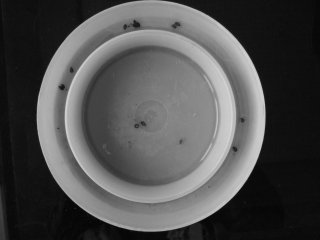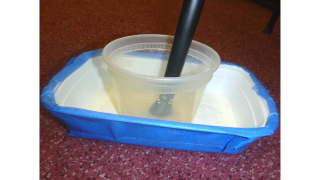Is There Any Easy Way to Kill Bed Bugs
Do-it-yourself Bed Bug Control
- Información relacionada disponible en español
Can you get rid of bed bugs on your own?
Treating bed bugs is complex and can take weeks to months, depending on the extent of the infestation. Your likelihood of success depends on many factors, including how many bed bugs you have, how much clutter is available for hiding places, whether your neighbors have bed bugs, and whether all residents of a house of building will participate
To be successful, everyone in the home will need to cooperate and do their part
The following steps will help you begin:
- Identify the problem
- Develop a plan
- Keep the infestation from expanding
- Prepare for treatment
- Kill the bed bugs
- Evaluate and prevent
You may have to follow these steps more than once to kill all the bugs and their eggs.
Identify the Problem
- Identify the pest:
- Collect a sample of the pest to show an extension agent other insect expert.
- Extension agents can identify the pest at no cost to you. They are trained in pest control and know your local area.
- If an extension agent or other expert says the pest is a bed bug, notify your landlord if you live in an apartment. The units near yours should be inspected.
- Landlords may have a responsibility to participate in treatment.
- Check the housing codes and laws in your area.
- Inspect all areas that may have bed bugs, plus surrounding living spaces, to find out the extent of infestation.
Develop a Plan
- Make a schedule for completing the steps below. Be sure to include any personal plans, such as vacations.
- Keep records through the whole process. Note the dates and exact locations where pests are found. This will help you track progress and better know where to target your work.
- Keep checking for at least a year after you're done to make sure all the bed bugs are gone.
Keep the Infestation from Spreading
- Seal any small hiding areas. Use silicon caulk to seal cracks and crevices. This eliminates hiding places and gets the bugs out into the open.
- Remove infested items. Place them in a sealed plastic bag and treat them. Learn more about treatment methods in the sections below.
- Items that cannot be treated should be placed in a sealed plastic bag or storage container and left there for up to a year to ensure any active bugs are dead.
- Purchase protective covers that seal mattresses and box springs. With covers that seal, the bed bugs will get trapped inside and die.
- Vacuum after each use. Seal the bag as tightly as possible and immediately throw it out in an outdoor trash container.
- Discard furniture responsibly if you can't safely eliminate the bed bugs. Destroy it so someone else won't be tempted to bring it into their home. For example:
- Rip covers and remove stuffing from furniture items.
- Use spray paint to mark furniture with "Bed Bugs."
- Have infested items picked up as soon as possible by the trash collection agency.
- Don't discard furniture if you can safely eliminate the bed bugs from it.
Prepare for Treatment
Preparing for treatment is very important; it will make it easier to monitor for bed bugs that haven't been eliminated. This preparation should be completed whether you are doing the treatment yourself or hiring a professional.
Learn more about preparing for treatment
Learn about treatment options (PDF).(4 pp, 480 K, About PDF)
Kill the Bed Bugs
- Make sure the methods you select are safe, effective and legal. See What's Legal, What's Not.
- Avoid treatments that don't work.
- Rubbing alcohol, kerosene and gasoline could harm you and your family and can easily ignite with a spark or cigarette.
- Sticky traps are not for bed bugs, but they may be effective at catching spiders, cockroaches, and other insects.
- See below to learn how to make your own bed bug interceptor traps.
- Consider non-chemical methods of killing bed bugs. Some will be more useful than others depending on your situation. These and other methods can be helpful, but they might not get rid of the infestation entirely:
- Heat treatment: You can use a clothes dryer on high heat. You can also use black plastic bags in a hot, closed car in the sun, but success depends on your climate and other factors. Do-it-yourself heat treatments might not work. Professionals have access to more intensive and proven methods that can even treat whole houses with heat. Do not try to kill bed bugs by increasing your indoor temperature with a thermostat, propane space heater, or fireplace - this does not work and is dangerous.
- Cold treatment may work, but can only be successful in the home environment if the freezer is set to 0o F. Many home refrigerator freezers are not cold enough to kill bed bugs. You must leave the items in a sealed bag in the freezer at 0o for three days. Always use a thermometer to check the temperature, since home freezers are not always set to 0o.
- Steam cleaners (wet or dry) can get into cracks and fabrics to treat carpets, baseboards, bed frames, and other furniture. The steam temperature must be at least 130o F but should not have a forceful airflow, or it may cause bed bugs to scatter. Use a diffuser to prevent scattering.
If needed, hire a pest management professional or use pesticides carefully according to the label directions:
- Look for EPA-registered pesticides that have bed bugs listed on the label.
- Use foggers (bug bombs) only with extreme care and only if bed bugs are listed on the label. Improper use can harm your health or cause a fire or explosion. Foggers should not be your only method of bed bug control. The spray will not reach the cracks and crevices where bed bugs hide. See Should I Use a Fogger? for more information.
Carefully look for any evidence of bed bugs every few days after you complete your initial cleanup and control processes. If you see bed bugs, either the initial cleanup missed some bugs or eggs have hatched. Retreatment may be needed.;
Consider using different types of pesticides if repeated treatments are needed.
- Desiccants (chemicals that dry things out) can be particularly effectivein some situations since they work by drying out the bug (which means the bed bugs can't develop resistance). However, t hey may take several months to work. If using desiccants, be sure to use only products registered by EPA as a Pesticide.
- Pool or food grade diatomaceous earthshould not be used. This type of diatomaceous earth (made from t he fossilized remains of tiny aquatic organisms called diatoms) can harm you when you breathe it in. The pesticide version uses a different size of diatoms, which reduces the hazard.
Bed bug interceptor traps can be placed under the legs of furniture to catch bed bugs and keep them from climbing the legs. Both commercial and do-it-yourself interceptors are options. Follow the directions below to create your interceptor traps.
Bed bug interceptors (place under furniture legs to catch bed bugs)
- Gather supplies you need to make your own interceptor traps:
- Two clean plastic containers with sturdy, tall side over 1 inch container fits inside the larger one). Cleaned and repurposed deli or take out food containers are a great option.
- Masking or painter's tape with a rough texture.
- Talcum powder.
- Follow these directions to make an interceptor trap:
- Ensure that the small container is large enough to set a bed or couch leg inside
- Place masking tape around the outside of the larger container so the bed bugs can easily climb up into the container.
- Glue or tape the two containers together, the small one sitting in the larger one.
- Sprinkle a little talcum powder into the bottom of both containers. Talcum is slippery and will keep the bed bugs inside the container.
- Make enough interceptor traps to be placed under each leg of the infested furniture such as beds, couch, or chairs.
- If needed, move y our furniture a few inches from any walls and ensure no lines are touching the floor, only the furniture legs ensure no linens are touching the floor, only the furniture legs.
- Check and clean the interceptors every week. Reapply talcum powder.
- Dispose of captured bed bugs into a plastic zip-type or sealable bag.
Evaluate and Prevent
- Continue to inspect for bed bugs (including monitoring interceptor traps if applicable) at least every 7 days in case any eggs remain.
- Click here to learn about a few simple precautions your can take that can help prevent bed bug infestation in your home.
- For additional information, please see:
Bed bugs — National Pesticide Information Center
Bed bugs: Do-it-yourself control options -- Texas A & M AgriLife Extension
Bed Bug Control in Residences -- University of Minnesota
Bed Bugs Integrated Pest Management in and Around the Home -- University of California
Source: https://www.epa.gov/bedbugs/do-it-yourself-bed-bug-control


Post a Comment for "Is There Any Easy Way to Kill Bed Bugs"